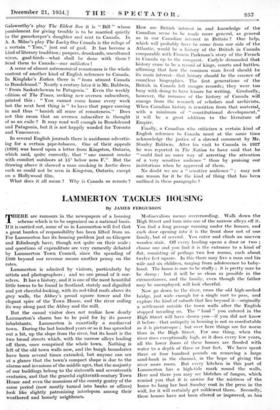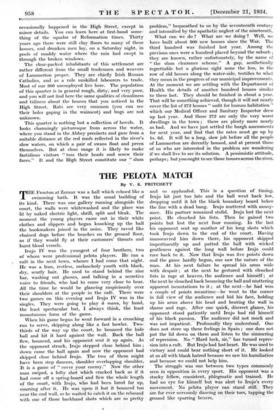LAMMERTON TACKLES HOUSING
By JAMES FERGUSSON
THERE are rumours in the newspapers of a housing scheme which is to be organized on a national basis. If it is carried out, some of us in Lammerton will feel that a great burden of responsibility has been lifted from us. For Lammerton has its housing probleni just as Glasgow and Edinburgh have, though not quite on their scale ; and questions of expenditure are very earnestly debated by Lannnerton Town Council, since the spending of k100 beyond our revenue means another penny on the rates.
Lammerton is admired by visitors, particularly by artists and photographers ; and we are proud of it our- selves. It has a history, and it is one of the most beautiful little towns to be found in Scotland, stately and dignified and yet cheerful-looking, with its red-tiled roofs above its grey walls, the Abbey's proud square tower and the elegant spire of the Town House, and the river coiling its way_ along past the Abbey and the mill.
But the casual visitor does not realize how dearly Lammerton's charm has to be paid for by its poorer inhabitants. Lammerton is essentially a mediaeval town. During the last hundred years or so it has sprawled out a bit, up the slope from the river, but its heart is the two broad streets which, with the narrow alleys leading off, them, once comprised the whole town. Nothing is left of the old town walls now, and the burgh boundaries have been several times extended, but anyone can see at a glance that the town's compact shape is due to the alarms and invasions of the middle ages, that the majority of our buildings belong to the sixteenth and seventeenth centuries, and that the graceful eighteenth-century Town House and even the mansions of the county gentry of the same period (now mostly turned into banks. or offices) look like slightly patronizing interlopers among their weathered and homely neighbours. Mediaevalism means overcrowding. Walk down the High Street and turn into one of the narrow alleys off- it. You find a long passage running under the houses, and each door opening into it is the front door not of one family, but of several. You enter and climb an uneven wooden stair. Off every landing opens a door or two ; choose one and you find it is the entrance to a kind of flat, consisting of perhaps two low rooms, each about twelve feet square. In this there may live a man and his wife and six children, ranging from adolescence to baby- hood. The house is sure to be stuffy ; it is pretty sure to be damp ; but it will be as clean as possible in the circumstances, and the family, even though the father may be unemployed, will look cheerful.
Now go down to the river, cross the old high-arched bridge, just wide enough for a single cart to pass, and explore the kind of suburb that lies beyond it—originally a settlement outside the town walls after the English stopped invading us. The " land " you entered in the High Street will have shown you—if you did not know it before—that antiquity in housing is not so comfortable as it is picturesque ; but over here things are far worse than in the High Street. For one thing, when the river rises exceptionally high, as it does every few years, all the lower floors of these houses are flooded with water to a depth of three or four feet. We have spent three or four hundred pounds on removing a large sand-bank in the channel, in the hope of giving the river more room. But every kitchen in this part of Lammerton has a high-tide mark round the walls. Here and there you may see blotches of fungus, which remind you that it is unwise for the mistress of the house to hang her best Sunday coat in the press in the wall, for it will certainly get mildewed there. Secondly, these houses have not been altered or improved, as has occasionally happened- in the High Street, ' except in minor details. You can learn here at first-hand some- thing of the squalor of Reformation times. Thirty years ago there were still clay floors to many of these houses, and drunken men lay, on a Saturday night, in pools of muddy water where the rain had swept in through the broken windows.
' The close-packed inhabitants of this settlement are rather different from the small tradesmen and weavers of Lammerton proper. They are chiefly Irish Roman Catholics, and as a rule unskilled labourers to trade. Most of our 300 unemployed live here. The_ population of this quarter is in general rough, dirty, and very poor, and you will not find here the same qualities of cleanliness and tidiness about the houses that you noticed in the High Street. Rats are very common (you can see their holes gaping in the wainscot) and bugs are not unknown.
This quarter is nothing but a collection of hovels. It looks charmingly picturesque from across the water, where you stand in the Abbey precincts and gaze from a suitable distance at the red roofs reflected in the river's slow waters, on which a pair of swans float and preen themselves. But at close range it is likely to make fastidious visitors " toss their heads and screw their faces." It and the High Street constitute our " shun problem," bequeathed to us by the seventeenth century and intensified by the apathetic neglect of the nineteenth.
What can we do ? What are we doing ? Well, we have built about 800 new houses since the War. The third hundred was finished last year. Among the previous ones were a hundred placed beyond the suburb they are known, rather unfortunately, by the name of " the slum clearance scheme." A gap, aesthetically regrettable- but a glorious sight none the less, in the row of old houses along the water-side, testifies to what they mean in the progreSs of our municipal improvements. At the moment we are settling with the Department of Health the details of another hundred houses similar to these last. They should be finished in about a year. That will be something achieved, though it will not nearly cover the list of 272 houses " unfit for human habitation " which our Medical Officer and Sanitary Inspector drew up last year. And those 272 are only the very worst dwellings in the town ; there are plenty more nearly as bad. And we have just settled the burgh assessments for next year, and find that the rates must go up by ls. 6d. It will be a long, slow job' before all the people of Lammerton are decently housed, and at present those of us who are interested in the problem are wondering if we shall live to see its solution. A pessimistic attitude, perhaps ; but you ought to see thOse houses across the river.



































 Previous page
Previous page